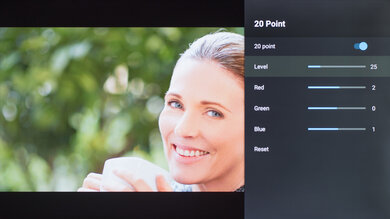- Table of Contents
- Top
- General Settings
- Motion Settings
- Gaming
- White Balance
- Discussions
We used the following calibration settings to review the55 inch Hisense H6510G (55H6510G) and we expect them to be valid for the 50 inch (50H6510G), 65 inch (65H6510G), 75 inch (75H6510G), and 85 inch (85H6510G) models too.
These settings should apply to most types of content, except for gaming or use as a PC monitor, which requires a few additional changes, listed below.
General Settings
Eco Settings
One of the first things we did was disable all of the Enhanced Viewing modes, as we don't want the TV to adjust the image during testing. From the Backlight menu, we also disabled Dynamic Backlight Control, as we don't want the backlight changing during calibration.
SDR
For SDR content, we recommend choosing the 'Theater Night' Picture Mode, as it is the most accurate one out of the box, and allows for the most customization. We recommend leaving Contrast at 46, Brightness at 50, Color at 45, Tint and Sharpness at 0; Brightness is an image processing option; we do not recommend changing this setting.
The backlight of the TV can be controlled from the Backlight sub-menu. You should adjust the Backlight Level to your viewing conditions. Note that this setting does not affect picture quality.
Advanced Settings
In the Advanced settings tab, we selected the 'Medium' Color Temperature setting, as this setting is closest to our target color temperature of 6500K. We left Noise Reduction and Digital Noise Reduction off, but if you are watching lower-quality content it might be able to improve the picture a bit. Note that these settings can result in a loss of fine details in some scenes.
HDR
HDR is automatically enabled for the native apps. When you start playing HDR content, a small HDR icon appears in the picture settings menu. Once you start playing HDR content, some of the settings change automatically. We recommend choosing the 'HDR Theater' Picture Mode and leaving the other settings to their defaults in HDR.
For HDR to work from external devices, the HDMI 2.0 Format option usually has to be enabled for the input you are using. Older devices may have compatibility issues if this option is left enabled, so it is recommended to only enable this setting for devices that require it.
Dolby Vision
The H6510G supports Dolby Vision, from native apps and with most external devices. As with normal HDR content, when you start playing Dolby Vision content, some settings change automatically. We recommend leaving these settings as-is; do not copy our SDR settings over. There are three Picture Modes in Dolby Vision: 'Dolby Vision Bright', 'Dolby Vision Dark', and 'Dolby Vision Custom'. We recommend 'Dolby Vision Bright'.
How to Make HDR Brighter
If you find HDR content too dim, setting Gamma to '1.8' and Active Contrast to 'High' results in a brighter image, as shown in this EOTF.
Motion Settings
Although we disable most motion enhancing functions for most of our tests, you should adjust these to whatever looks best for you. However, this TV is quite limited in what it offers for motion settings.
Judder Settings
This TV automatically removes judder from native 24p sources, and no extra settings are required.
Gaming
From the base SDR and HDR settings, very few changes are required for a great gaming experience. When you start gaming, it is best to switch to the 'Game' Picture Mode, to get the lowest input lag, and use the recommended settings for SDR or HDR. For HDR gaming, it is important to make sure that HDMI 2.0 Format is enabled for the input you are using.
PC Gaming
Unlike TVs from most other brands, no special settings are required for PC use on this TV. Just make sure you are using the 'Game,' Picture Mode, and that HDMI 2.0 Format is enabled for the input you are using.
White Balance Settings
The following are the results of the white balance and colorspace calibration on our unit. They are provided for reference, and should not be copied as the calibration values vary per individual unit even for the same model and same size as the TV we reviewed due to manufacturing tolerances. If you want to try them you will need to enter all values shown, as all of them are active at the same time. If you end up with worse picture quality, simply reset them to the default values.



















































































